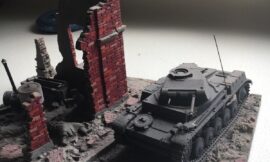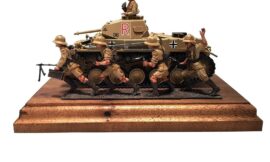The Panzer III, officially known as the Panzerkampfwagen III (PzKpfw III), was a pivotal German medium tank developed in the 1930s and widely used during World War II. As a key component of the Wehrmacht’s armored forces, the Panzer III played a crucial role in the early blitzkrieg campaigns and saw extensive action on various fronts.
Development and Specifications
Early Development
The development of the Panzer III began in 1936 with the aim of creating a medium tank capable of engaging and destroying other tanks. The primary contractor for its design was Daimler-Benz, and the first prototypes were completed in 1937. The Panzer III was initially equipped with a 3.7 cm KwK 36 L/45 gun, but as the war progressed, it was up-gunned to a more powerful 5 cm KwK 38 L/42 and later to a longer 5 cm KwK 39 L/60 gun to improve its anti-tank capabilities.
Specifications
- Armament: The Panzer III’s main armament evolved from a 3.7 cm gun to a 5 cm gun. Later versions even experimented with a 7.5 cm KwK 37 L/24.
- Armor: The tank’s armor ranged from 5 mm to 70 mm, depending on the variant, providing better protection compared to earlier tanks like the Panzer II.
- Engine: Powered by a Maybach HL 120 TRM V-12 gasoline engine, the Panzer III could reach speeds of up to 40 km/h (25 mph) on roads and had a range of about 155 km (96 miles) on roads.
- Crew: The Panzer III was manned by a crew of five: commander, gunner, loader, driver, and radio operator.
Operational History
Early Campaigns
The Panzer III first saw combat during the invasion of Poland in 1939, but it was in the Battle of France in 1940 that it played a more significant role. It was designed to engage enemy tanks while the infantry supported and protected the more vulnerable Panzer IV, which was initially intended to provide infantry support with its short-barreled 7.5 cm gun.
North Africa and Eastern Front
The Panzer III also saw extensive service in North Africa under General Erwin Rommel, where its reliability and mobility were advantageous in the desert terrain. However, its relatively light armor and armament became increasingly apparent against British and later American tanks, necessitating constant upgrades.
On the Eastern Front, the Panzer III faced the formidable Soviet T-34 and KV-1 tanks. Despite initial successes, the Panzer III struggled to match the firepower and armor of these Soviet designs. The longer 5 cm gun provided some improvement, but it was clear that the Panzer III was becoming obsolete as a front-line tank.
Variants and Adaptations
StuG III
One of the most significant adaptations of the Panzer III chassis was the Sturmgeschütz III (StuG III), an assault gun armed with a 7.5 cm StuK 40 L/48 gun. The StuG III proved to be an effective tank destroyer and infantry support vehicle, with over 10,000 units produced, making it one of the most produced German armored fighting vehicles of the war.
Command and Support Variants
The Panzer III chassis was also used for command tanks, flamethrower tanks, and artillery observation vehicles. These variants provided essential support roles within the Panzer divisions, extending the utility of the Panzer III beyond its primary tank-fighting role.
Legacy and Impact
The Panzer III was a crucial element of Germany’s armored forces during the early years of World War II. Its design influenced the development of later German tanks, and its chassis served as the foundation for several successful armored vehicles, including the StuG III. While eventually outclassed by more advanced enemy tanks, the Panzer III’s contributions to early German victories and its adaptability in various roles underscore its importance in armored warfare history.
Conclusion
In summary, the Panzer III was a key player in Germany’s early war strategy, providing a balance of firepower, protection, and mobility that was effective in the blitzkrieg tactics of the early 1940s. Its versatility and the subsequent adaptations of its chassis into other roles ensured that the Panzer III remained a valuable asset throughout the war, even as newer and more powerful tanks emerged on the battlefield.










